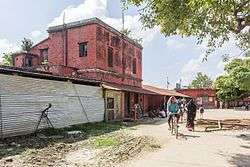Nepal Railways
| Jayanagar - Janakpur - Bijalpura | ||||||||||||||||||||||||||||||||||||||||||||||||||||||||||||||||||||||||||||||||||||||||||||||||
|---|---|---|---|---|---|---|---|---|---|---|---|---|---|---|---|---|---|---|---|---|---|---|---|---|---|---|---|---|---|---|---|---|---|---|---|---|---|---|---|---|---|---|---|---|---|---|---|---|---|---|---|---|---|---|---|---|---|---|---|---|---|---|---|---|---|---|---|---|---|---|---|---|---|---|---|---|---|---|---|---|---|---|---|---|---|---|---|---|---|---|---|---|---|---|---|---|
 Janakpur station | ||||||||||||||||||||||||||||||||||||||||||||||||||||||||||||||||||||||||||||||||||||||||||||||||
 Map of Nepal, with the railway line | ||||||||||||||||||||||||||||||||||||||||||||||||||||||||||||||||||||||||||||||||||||||||||||||||
| Line length: | 50 | |||||||||||||||||||||||||||||||||||||||||||||||||||||||||||||||||||||||||||||||||||||||||||||||
| Track gauge: | 1,676 mm (5 ft 6 in) | |||||||||||||||||||||||||||||||||||||||||||||||||||||||||||||||||||||||||||||||||||||||||||||||
| ||||||||||||||||||||||||||||||||||||||||||||||||||||||||||||||||||||||||||||||||||||||||||||||||
The Nepal Railways Corporation Ltd. (NRC, reporting mark: NR / ने. रे) is owned by the Nepalese Government.
It maintains and operates two railway lines: the Raxaul-Sirsiya line, which is a 6 km, 1,676 mm (5 ft 6 in) line from Raxaul in India to Sirsiya Inland Container Depot (or Dry Port) near Birganj in Nepal; and the Jaynagar-Janakpur line, which is a 53 km, 1,676 mm (5 ft 6 in) line from Jaynagar in India to Janakpur in Nepal.
The Jainagar-Janakpur line is primarily used for passenger transport, while the Raxaul-Sirsiya line is primarily used for freight transport.
History
The Raxaul- Amlekhagunj section of the Nepal Government Railway (NGR) was built from a 2 ft 6 in (762 mm) narrow gauge railway, introduced to Nepal during the Rana period. The 39 km long NGR, built in 1927 by the British, was important as it allowed people from different areas of the country to reach Amlekhganj and to get lorries to Bhimphedi. One could then reach Kathmandu from Bhimphedi on foot. The railway was later closed down.
The Jayanagar-Janakpur Line (NJJR), a 2 ft 6 in (762 mm) narrow gauge railway was also introduced during the Rana period. The Jayanagar-Janakpur-Bijalpura line is under gauge conversion to 1,676 mm (5 ft 6 in) with an extension to Bardibas.[1]
The 1676 km long 1,000 mm (3 ft 3 3⁄8 in) metre gauge railway track from Raxaul was converted to 1,676 mm (5 ft 6 in) by the Indian railways to connect Sirsiya (Birganj) Inland Container Depot (ICD).The railway became fully operational in 2005. It helps move containers and other cargo to and from the Kolkata port and other places in India. It is the most important entry point for imports into Nepal, and is essential for Nepal's commerce and trade. Birganj is located 700 km (430 mi) from the Kolkata port by railway.
Today, all Nepal Railway lines use 1,676 mm (5 ft 6 in) gauge lines.
Future expansion
Nepal has an ambitious plan for the East-West Railway, including linking it to Kathmandu and the North-South Railway line, which would link to the railway systems of India and China through Kathmandu.
The Lumbini-Hetauda-Janakpur section is thought to be the first East-West Railway line in Nepal. These two entry points will be valuable for tourists. Further, they are among the most economical routes for trade with India and overseas.
The Birganj Dry Port was the first in Nepal to be connected by broad gauge link. Biratnagar may be the second such point and Mahendranagar may get a similar link.
Survey and plans
RITES of Indian Railways has conducted preliminary surveys for the following broad gauge lines:
- New Jalpaiguri (India) to Kakadvitta (Nepal)
- Jogbani (India) to Biratnagar (Nepal)
- Nautanwa (India) to Bhairahawa (Nepal)
- Nepalganj Road (India) to Nepalganj (Nepal)
Railway stations
- Raxaul-Sirsiya Birganj – Entry point in Nepal for containers and break-bulk cargo
- Jaynagar – Jayanagar in India interchange and break-of-gauge
- Janakpur – A town in Nepal
- Bijalpura – Terminus in Nepal[2]
Safety
The Nepal Railways Corporation has a good safety record. In August 2012 a serious incident occurred when a locomotive ran away after the driver alighted for refreshment. The unmanned locomotive ran from Jaynagar to Janakpur at speeds far exceeding the restrictions on the line.
At Janakpur staff diverted the light engine onto a disused siding on which they had placed heavy obstructions. The engine was halted and no-one was injured.[3]
See also
| Wikimedia Commons has media related to Nepal Railways. |